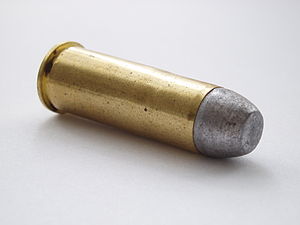.44-40 WCF
| .44-40 WCF | |
|---|---|

|
|
| general information | |
| caliber | .44-40 WCF (10.8 × 33 R) |
| Sleeve shape | Rim cartridge |
| Dimensions | |
| Sleeve shoulder ⌀ | .457 inch, 11.6 mm |
| Sleeve neck ⌀ | .443 inch, 11.3 mm |
| Floor ⌀ | .427 inch, 10.8 mm |
| Cartridge bottom ⌀ | .520 inch, 13.2 mm |
| Sleeve length | 1,310 inches, 33.3 mm |
| Cartridge length | 1,587 inches, 40.3 mm |
| Weights | |
| Bullet weight | 14-17 g |
| Powder weight | Black powder 40 grains, 2.6 g |
| Technical specifications | |
| Speed v 0 | 396 m / s |
| Bullet energy E 0 | 1016 J. |
| Lists on the subject | |
The .44-40 WCF cartridge (.44-40 Winchester Center Fire) introduced in 1873 was the successor to the .44 Henry cartridge with rimfire ignition . In contrast to this, it was a powerful center fire cartridge for its time . It was developed for the Winchester Model 73 rifle, the successor to the Model 66. As early as 1874, the equally heavily charged .38-40 WCF cartridge in a slightly smaller caliber was brought onto the market.
history
After the success of the Winchester Mod. 1866 rifle, the Winchester Repeating Arms Company developed a reinforced version of this weapon. Instead of bronze , iron was used for the lock housing . The center fire cartridge developed for the weapon had the same caliber .44, boxer ignition and a black powder charge increased to 40 grains . The rifle called Winchester Mod. 73 and the carbine, like its cartridge, quickly became a sales success; twenty years later, over 400,000 of these weapons had already been sold, and in 1885 the company launched the Model 1885, a single-shot rifle that was also available in the same caliber.
Just one year after the cartridge was introduced, on October 20, 1874, Winchester had a reloading device patented, the device allowed the removal of the fired primer , the calibration of the case and the insertion of the projectile and the new primer.
From 1875 Remington offered a .44-40 caliber revolver with the Model 1875 Frontier Army , in 1877 Colt followed suit with the Colt Frontier Six Shooter , the .44-40 version of the Colt Single Action Army revolver, and a year later the Colt Model 1878 Double Action was launched. Another manufacturer was Smith & Wesson , who only brought out a .44-40 No. 3 single-shot revolver in 1885, as the company was busy manufacturing its revolvers for foreign countries, and the frame and drum had to be longer. 44-40 cartridge.
Colt brought the Colt-Burgess lever action rifle in caliber .44-40 WCF onto the market from 1883–1885, but had to stop production after 6,403 copies were made, as Winchester threatened to start production of revolvers. Just one year later, Colt responded with the Lightning front rifle with tubular magazine and offered the .44-40 WCF corresponding cartridge under the designation .44 CLMR (.44 Colt Lightning Magazine Rifle) Cartridge. Other manufacturers were Marlin with the lever action rifle Model 1888 and Remington with the rolling block single-shot rifle. The number of cartridges sold by the various suppliers can only be estimated, the fact is that it was the most widely used civilian cartridge in the American West.
The company Marble Arms Company , Gladstone, Michigan, used the charged with a round ball .44-40 cartridge in the prepared 1908-1942 Game getter -Kombiwaffe; a pistol with a shotgun and a rifled .22 break barrel and hinged butt stock. It was used as a light hunting and defensive weapon in the wild.
With the "Model 1892" developed by John Browning , Winchester launched a lever action rifle that was also suitable for firing smokeless cartridges.
Even before the turn of the century, the manufacture of cartridges with smokeless powder began. In the case of the .44-40 cartridges used by Winchester, however, the external ballistic data of the black powder cartridges were retained.
From 1903 onwards, Winchester produced a .44-40 WHV (Winchester High Velocity) cartridge for exclusive use in rifles. A 200-grain bullet fired from a 24-inch barrel reached a muzzle velocity of 1,500 ft / s (460 m / s).
When the United States entered World War II, production of the cartridge ceased, but resumed after the war with the advent of cowboy action shooting .
Modern ammunition
200 grain bullets fired from rifle barrels achieve a muzzle velocity of approximately 1310 ft / s (400 m / s), from a 7-1 / 2 "turret it is approximately 975 ft / s (297 m / s) Source: Ballistics of Winchester Western cartridges 1956, cartridge designation W4440 . In addition, stronger loads for rifles are manufactured "for rifles only". Reloaders like to manufacture their ammunition for reasons of precision and economy. The amount of smokeless powder to be loaded is depending on the type of powder and Bullet now only 7 to 23 grains instead of 40 grains of black powder. Only cartridges filled with black powder or weakly charged cartridges with the designated smokeless powder may be fired from original original weapons. Smokeless ammunition may only be fired from original Colt Single Action Army revolvers if they have the VP inspection mark (triangular shape) on the trigger guard.
literature
- George Madis: The Winchester Handbook . Art & Reference House, Brownsboro, TX 1981, ISBN 0-910156-04-2 .
- John E. Parsons: The First Winchester . William Morrow & Co., New York, NY 1955, LCCN 55-007621 .
- George Madis: The Winchester Book . Taylor Publishing Company, Dallas, TX 1971, ISBN 0-910156-03-4 .
- Norm Flayderman: Flayderman's Guide to Antique Firearms . Krause Publications, Iola, WI 2001, ISBN 0-87349-313-3 .

